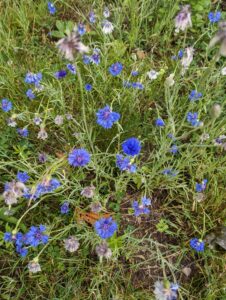 You won’t find a lot of men wearing boutonnieres or, in the more prosaic English translation, “buttonholes”, these days. Individual blooms stuck through the buttonhole of a jacket or pinned to a lapel are still on view at weddings, proms and other festive events, but the days when fashionable, suit-wearing men wore a fresh flower to work are long gone. Pinning a blossom to a tee shirt just doesn’t seem to make sense.
You won’t find a lot of men wearing boutonnieres or, in the more prosaic English translation, “buttonholes”, these days. Individual blooms stuck through the buttonhole of a jacket or pinned to a lapel are still on view at weddings, proms and other festive events, but the days when fashionable, suit-wearing men wore a fresh flower to work are long gone. Pinning a blossom to a tee shirt just doesn’t seem to make sense.
Bachelor’s buttons acquired their most common nickname from this practice. The Latin name, Centaurea cyanus, is more suggestive of little blue centaurs, but folklore indicates that in earlier days, a would-be swain would sometimes pop a bachelor’s button onto a lapel before a courting visit. If the flower faded quickly, it signified lack of interest from the woman.
Flower fables like that one are romantic, but mostly fanciful. A fading flower generally means that it was picked late in the bloom cycle. For the best chances of success, sensible would-be-lovers should always select fresh bachelor’s buttons.
Boutonniere or not, bachelor’s buttons are appealing annual flowers that make themselves known in earliest summer alongside the first daisies and coreopsis. This is not surprising, since all three are part of the large and far-ranging Compositae or daisy family. The blue-flowered bachelor’s button varieties, with their frilly heads of ragged-edged petals, are the most common, but you can also buy varieties with pink, red, white, or near-black blooms. Bi-colored flowers, often with dramatic, dark centers, are available commercially and seed vendors also offer multi-color mixes.
Some people scorn the “bachelor” affiliation and refer to these annuals as “cornflowers”. In their native Europe and in adopted homes, including the United States, Centaurea cyanus long ago jumped garden fences or expanded beyond native habitats and self-seeded in farmers’ fields, leading to the cornflower nickname. You sometimes see the phrase “cornflower blue” to describe fabrics, paints or other products that mimic the classic bachelor’s button color.
The plants have been in the United States almost as long as European colonists, who brought the seeds with them, either accidentally or deliberately, on their journey to this part of the world. Sun-loving and easy to care for, they became cottage garden classics and acquired a host of other nicknames along the way. American garden historian Denise Wyles Adams mentions colorful monikers like “great blue bottle,” “ragged sailor,” “bluet”, “bluebottle,” “French pink” and “bluette.”
Whatever you call them, bachelor’s buttons are among the easiest annuals to grow, thriving in loamy soil and full sun. Standing about 18 inches tall, the lanky, branching stems produce long, gray-green leaves and abundant flowers, especially if you deadhead the fading blooms and defeat—at least temporarily—the plants’ biological imperative. If you don’t deadhead, or at let at least a few of the flowers stay on the plants, bachelor’s buttons will self-seed with wild abandon, making them effectively perennial. A church near my house has a stand of classic blue bachelor’s buttons near the parking area. The bed was probably planted ten years ago, and new generations of plants flowers nicely each year with no apparent earthly assistance.
You may not be inclined to use these cornflowers as boutonnieres, but they also work well in cut-flower arrangements, sharing the daisy family trait of long vase life.
Even garden novices can grow these cornflowers from seed. Sow in containers or directly in beds, cover lightly with soil and water regularly. Buying seeds gives you the most color choice. Look for the ‘Ball’ series, which includes double-flowered varieties in blue, white, and near-black. The ‘Gem’ series also offers a variety of colors. Several different mixed color combinations are available under the ‘Classic’ name. ‘Blue Boy’, with its bright blue blooms is a standout variety in the most common color. With pink in vogue everywhere, you may favor ‘Pinkie’ for its pastel flowers. For something a little flashier, the ‘Fireworks’ mix is a classic red, white and blue combination—perfect for patriotic holidays.
You can still buy bachelor’s button seeds. Planted now, they will flower by the end of summer and self seed for next season. Some garden centers may still have flats available as well. Mail order vendors offer various varieties. Try Select Seeds, 180 Stickney Hill Road, Union, CT 06076; 1(800) 684-0395; www.selectseeds.com. Print catalog available.
